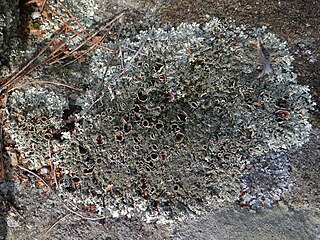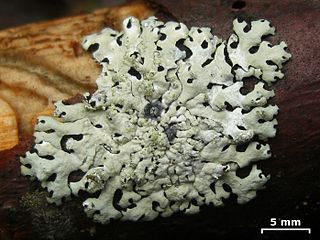
Parmelia is a genus of medium to large foliose lichens. It has a global distribution, extending from the Arctic to the Antarctic continent but concentrated in temperate regions. There are about 40 species in Parmelia. In recent decades, the once large genus Parmelia has been divided into a number of smaller genera according to thallus morphology and phylogenetic relatedness.

Pseudevernia is a genus of foliose lichens in the family Parmeliaceae. The type species of the genus, Pseudevernia furfuracea, has substantial commercial value in the perfume industry.

Arctoparmelia is a genus of ring lichens in the family Parmeliaceae. The genus was circumscribed by American lichenologist Mason Hale in 1986 with A. centrifuga as the type species. Hale included five species in his original conception of the genus; the Siberian species A. collatolica was added in 2019.

Myelochroa is a genus of foliose lichens in the family Parmeliaceae. They are commonly known as axil-bristle lichens. It was created in 1987 to contain species formerly placed in genus Parmelina that had a yellow-orange medulla due to the presence of secalonic acids. Characteristics of the genus include tightly attached thalli with narrow lobes, cilia on the axils, and a rhizinate black lower surface. Chemical characteristics are the production of zeorin and related triterpenoids in the medulla. Myelochroa contains about 30 species, most of which grow on bark. The genus has centres of distribution in Asia and North America.

Flavoparmelia is a genus of foliose lichens in the family Parmeliaceae. Because of their appearance, they are commonly known as greenshield lichens. The widely distributed genus contains 32 species. It was circumscribed by American lichenologist Mason Hale in 1986 to contain 17 former Pseudoparmelia species with broad lobes, usnic acid in the cortex, and isolichenan in the cell walls.

Parmotrema is a genus of lichen belonging to the family Parmeliaceae. It is a large genus, containing an estimated 300 species, with a centre of diversity in subtropical regions of South America and the Pacific Islands.

Xanthoparmelia is a genus of foliose lichen in the family Parmeliaceae. Xanthoparmelia is synonymous with Almbornia, Neofuscelia, Chondropsis, Namakwa, Paraparmelia, and Xanthomaculina. This genus of lichen is commonly found in the United States, as well as Australia, New Zealand and Ecuador.
Psiloparmelia is a genus of lichen belonging to the family Parmeliaceae. It contains 13 Southern Hemisphere species, most of which are found growing on rocks at high elevations in South America. There are several characteristic features of the genus that are used to distinguish it from the morphologically similar genera, such as Arctoparmelia, Flavoparmelia, and Xanthoparmelia. These include a dark, velvety lower thallus surface that usually lacks rhizines, a negative test for lichenan, and a high concentration of usnic acid and atranorin in the cortex.

Esslingeriana is a fungal genus in the family Parmeliaceae. The genus is monotypic, containing the single foliose lichen species Esslingeriana idahoensis, commonly known as the tinted rag lichen. It is found in northwestern North America.

Xanthoparmelia mougeotii is a species of foliose lichen belonging to the family Parmeliaceae.

Xanthoparmelia conspersa, commonly known as the peppered rock-shield, is a foliose lichen and the type species of genus Xanthoparmelia. It is widely distributed in temperate zones, and has been recorded from Japan, Europe, Africa, North America, and South America.

Xanthoparmelia mexicana, commonly known as the salted rock-shield, is a foliose lichen in the family Parmeliaceae. It grows in 4–10 cm diameter rosettes of gray-green to yellow-green lobes in arid climates all over the world.

Xanthoparmelia scabrosa, jocularly known as sexy footpath lichen or sexy pavement lichen, is a foliose lichen in the family Parmeliaceae. It tolerates a very wide range of substrata, predominantly rock but also tree bark, roofing tiles, glass, and in wetter areas bitumen paths and roads.

Parmotrema rampoddense, commonly known as the long-whiskered ruffle lichen, is a species of foliose lichen in the family Parmeliaceae. It is widely distributed in tropical regions and grows on the bark of oak and palm trees.

Parmotrema arnoldii, commonly known as the powdered ruffle lichen, is a widely distributed species of lichen in the family Parmeliaceae. It has been recorded from Africa, Asia, Europe, Oceania, Macaronesia, and North and South America.

Xanthoparmelia lineola, commonly known as the tight rock-shield, is a foliose lichen species in the genus Xanthoparmelia. It is a common species with a temperate distribution. Found in North America and South Africa, it grows on rocks.
Bulbothrix meizospora is a species of foliose lichen in the family Parmeliaceae. It is found in Africa, Asia, and South America, where it grows on tree bark.

Protoparmelia badia is a species of crustose lichen in the family Parmeliaceae. It is a widely distributed, common species that grows on rocks.
Xanthoparmelia serusiauxii is a species of foliose lichen in the family Parmeliaceae. Found in Namibia, it was formally described as a new species in 1986 by American lichenologist Mason Hale. The type specimen was collected by Hale from the Laguneberg Mountains, southeast of Cape Cross. There, it is common on dolerite boulders and small, flat pebbles. The specific epithet honours Emmanuël Sérusiaux, who, according to Hale, "was the first lichenologist to collect this unusual lichen in Namibia".

Hypotrachyna osseoalba, commonly known as the grainy loop lichen, is a species of foliose lichen in the family Parmeliaceae. It is widely distributed in subtropical and temperate areas of the world. Characteristic features of the lichen include the pustules in its cortex, the somewhat linear shape of the lobes comprising the thallus, and the branched rhizines.
















